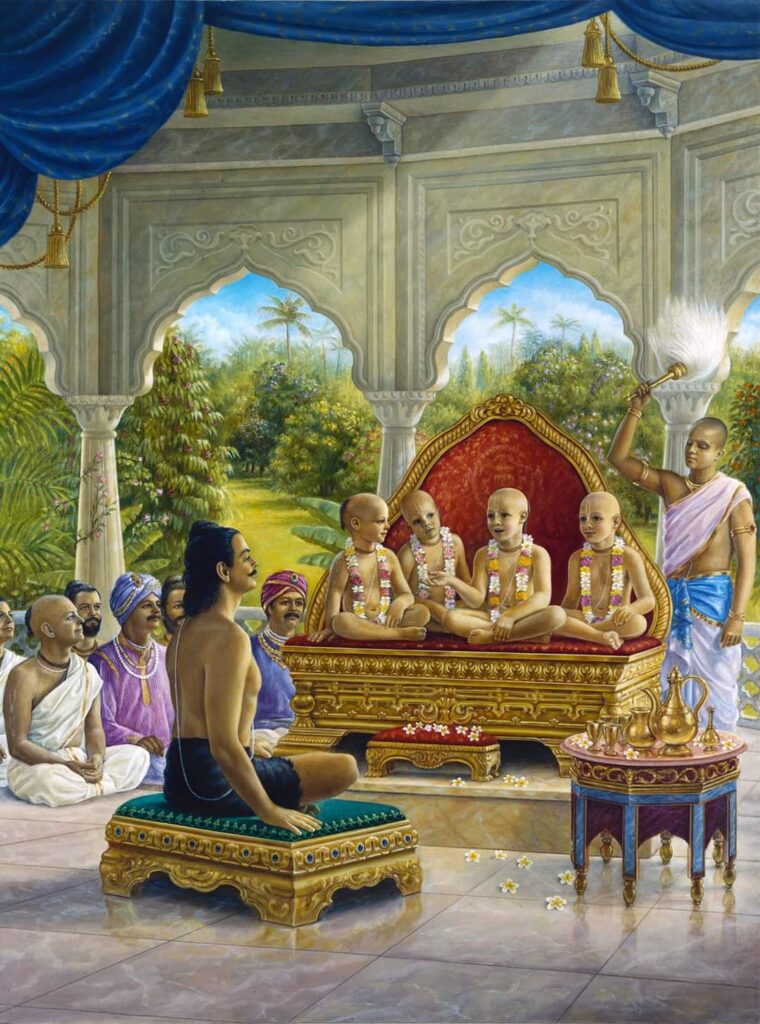Srila Visvanatha Cakravarti Thakura connects verses 16 to 21 from the second chapter of the first canto of Srimad Bhagavatam with 14 stages of spiritual development, showing how these few verses of the Srimad Bhagavatam teach us, in a nutshell, how to achieve ultimate perfection. Naturally, just understanding this description will not make us pure devotees, but it can help us to become aware of the path ahead of us.

According to his explanation, verses 16 and 17 describe the first five stages:
“O twice-born sages, by serving those devotees who are completely freed from all vice, great service is done. By such service, one gains affinity for hearing the messages of Vāsudeva.
Śrī Kṛṣṇa, the Personality of Godhead, who is the Paramātmā [Supersoul] in everyone’s heart and the benefactor of the truthful devotee, cleanses desire for material enjoyment from the heart of the devotee who has developed the urge to hear His messages, which are in themselves virtuous when properly heard and chanted.”
1- Satam krpa: the mercy of devotees. By the causeless mercy of devotees, we get the opportunity to engage in the second stage. Causeless means there is no cause, devotees are compassionate to all and are willing to bestow their mercy on anyone who crosses their path.
2- Mahat-seva: service to devotees. By serving devotees the process of cleansing the heart starts.
3- Sraddha: faith. By serving devotees and associating with them we acquire some preliminary faith in the process of bhakti, and this allows us to develop our practice.
4- Gurupadasraya: seeking the shelter of a bonafide spiritual master. What is the difference between friendly association with devotees, and the association with the spiritual master? Prabhupada answers on BG 2.7. When we talk with friends we may or not follow what they say, but talks with the spirtual master are serious. When we accept a spiritual master we give him the authority for correcting us and keeping us on the right path.
5- Bhajanesu sprha: eagerness to worship the Lord. By properly following the principles of bhakti under the instructions and example of the spiritual master, one eventually develops a taste for serving the Lord. From this taste of serving the Lord, the desire for material enjoyment is gradually cleansed.
Verse 18 describes three more:
“By regular attendance in classes on the Bhāgavatam and by rendering of service to the pure devotee, all that is troublesome to the heart is almost completely destroyed, and loving service unto the Personality of Godhead, who is praised with transcendental songs, is established as an irrevocable fact.”
6- Bhakti: Here loving devotional service to the Lord starts to manifest.
7- Anarthapagamam: At this stage, obstacles on the path are cleared. The anarthas in the heart are almost completely removed. This is the realization of the sentence naṣṭa-prāyeṣv abhadreṣu (all that is troublesome to the heart is almost completely destroyed) mentioned in the verse.
8- Tatha Nistha: As a result of the clearing of anarthas, there is finally bhaktir bhavati naiṣṭhikī, one becomes very steady on the practice of devotional service, and by this practice advances further.
Text 19 describes two more:
“As soon as irrevocable loving service is established in the heart, the effects of nature’s modes of passion and ignorance, such as lust, desire and hankering, disappear from the heart. Then the devotee is established in goodness, and he becomes completely happy.”
9- Ruci: Taste. At this stage, one develops arucya (distaste) for sense enjoyment, and conversely develops a taste for spiritual practice. This level comes as a result of the stages of Gurupadasraya and Bhajanesu sprha that start earlier. The stage of bhajanesu sprha is a form of preliminary eagerness to serve and worship, but ruci is real spiritual taste.
10- Atha Asakti: firm attachment. This is the phase where one becomes firmly attached to the service of Krsna.
Texts 20 and 21 describe the last four:
“Thus established in the mode of unalloyed goodness, the man whose mind has been enlivened by contact with devotional service to the Lord gains positive scientific knowledge of the Personality of Godhead in the stage of liberation from all material association.
Thus the knot in the heart is pierced, and all misgivings are cut to pieces. The chain of fruitive actions is terminated when one sees the self as master.”
11- Ratih: fondness. At this stage, love of Godhead starts to manifest. One becomes fully satisfied in serving the Lord.
12- Prema: pure love. This is the stage where one’s love for Krsna becomes fully manifested. Ratih is like dawn, where the light of the sun starts to manifest, while Prema is like midday, where the sun is at its maximum.
13- Atha darsanam: direct audience. Following the development of pure love, one starts to directly experience the Lord’s form, qualities, pastimes, etc.
14- Harer madhuryanubhava: At this stage one’s spiritual body is fully manifest and one can directly associate with Krsna.
A similar description of these different levels of spiritual development is given in the Caitanya Caritamrta, Madya-lila (23.14-15).
1- Sraddha: faith.
2- Sadhu-sanga: association with devotees.
3- Bhajana-kriya: performance of devotional service under the shelter of the spirtual master.
4- Anartha nivrtti: the diminishing of unwanted habits and attachments.
5- Nistha: steadiness, firm faith.
6- Ruci: taste.
7- Asakti: firm attachment.
8- Bhava: love.
9- Prema: pure love for Krsna.
That’s basically the same description, but some of the levels are combined, and thus we have only 9 levels instead of 14. The meaning however is the same.
